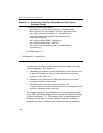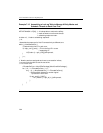
IA-32 Intel® Architecture Optimization
7-52
Arrangements of affinity-binding can benefit performance more than
other arrangements. This applies to:
• Scheduling two domain-decomposition threads to use separate cores
or physical packages in order to avoid contention of execution
resources in the same core
• Scheduling two functional-decomposition threads to use shared
execution resources cooperatively
• Scheduling pairs of memory-intensive threads and
compute-intensive threads to maximize processor scaling and avoid
resource contentions in the same core
An example using the 3-level hierarchy and relationships between the
initial APIC_ID and the affinity mask to manage thread affinity binding
is shown in Example 7-12. The example shows an implementation of
building a lookup table so that the sequence of thread scheduling is
mapped to an array of affinity masks such that threads are scheduled
if (ThreadAffinityMask & SystemAffinity){
Set thread to run on the processor specified in ThreadAffinityMask.
Wait if necessary and ensure thread is running on specified processor.
apic_conf[ProcessorNum].initialAPIC_ID = GetInitialAPIC_ID();
Extract the Package, Core and SMT ID as explained in three
level extraction algorithm.
apic_conf[ProcessorNum].pkg = PACKAGE_ID;
apic_conf[ProcessorNum].core = CORE_ID;
apic_conf[ProcessorNum].smt = SMT_ID;
apic_conf[ProcessorNum].affinity_mask = ThreadAffinityMask;
ProcessorNum++;
}
ThreadAffinityMask <<= 1;
}
NumStartedLPs = ProcessorNum;
Example 7-11 Assembling 3-level IDs, Affinity Masks for Each Logical
Processor (Contd.)


















